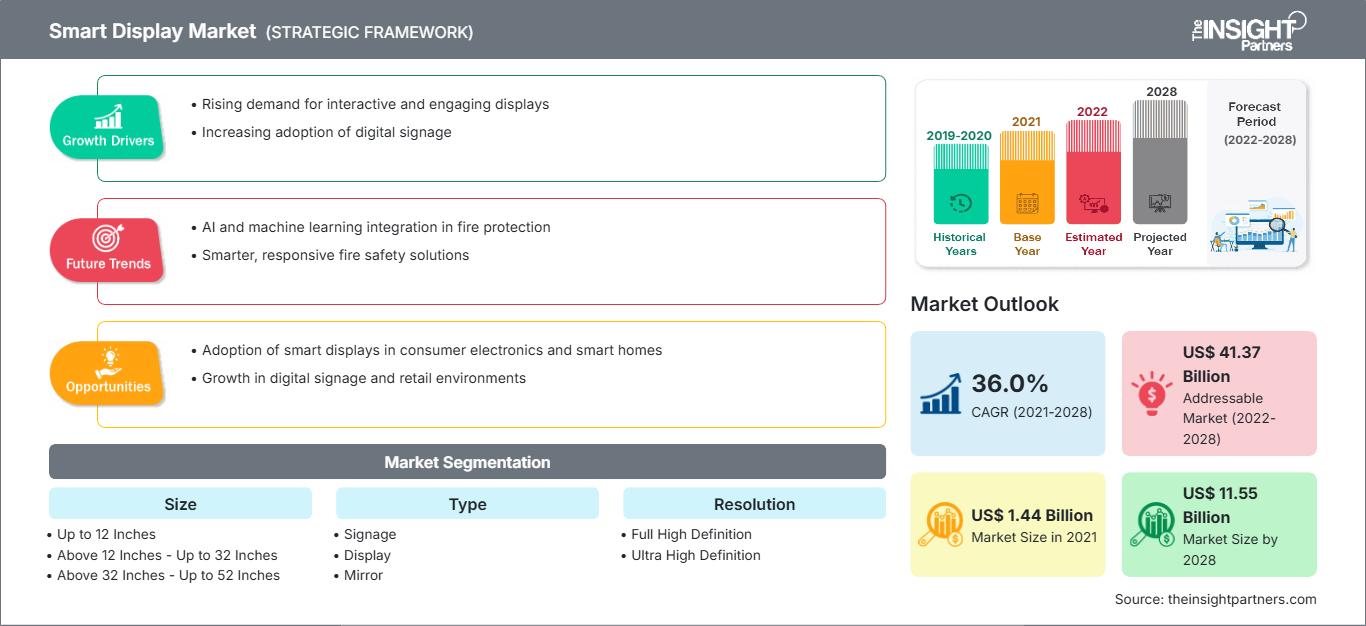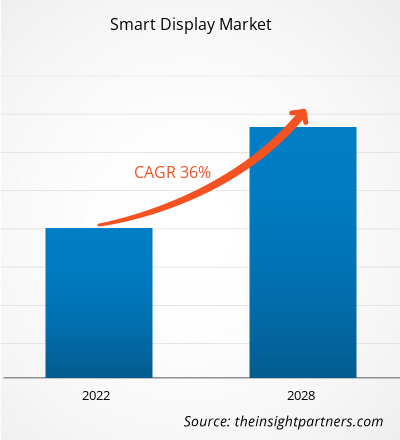Il mercato degli smart display è stato valutato a 1.443,74 milioni di dollari nel 2021 e si prevede che raggiungerà gli 11.547,23 milioni di dollari entro il 2028; si stima che registrerà un CAGR del 36,0% dal 2022 al 2028.
Uno smart display è un display digitale che può essere azionato tramite dispositivi di controllo vocale o dispositivi connessi all'Internet of Things (IoT). Ad esempio, uno specchio intelligente è un dispositivo innovativo che registra le informazioni personali degli utenti e l'esperienza degli acquirenti nei settori automobilistico e della vendita al dettaglio. Inoltre, in quanto soluzione tecnica all'avanguardia, lo smart display include funzioni di controllo interattive e complesse.
L'elevata domanda di specchietti intelligenti da parte del settore automobilistico, le nuove e innovative funzionalità offerte dagli specchietti intelligenti, il crescente numero di utenti Internet e la crescente adozione di dispositivi intelligenti in base alle preferenze dei consumatori, la crescente domanda di elettrodomestici intelligenti basati sull'intelligenza artificiale e sull'IoT, la crescente tendenza alla segnaletica contestuale e la crescente adozione della segnaletica intelligente nel settore retail sono i principali fattori trainanti della crescita del mercato degli smart display.
La crescita del settore retail è supportata dall'aumento del potere d'acquisto dei consumatori. Inoltre, la rapida espansione dei centri commerciali e degli spazi commerciali in tutto il mondo stimola la domanda di soluzioni di segnaletica intelligente per attrarre i passanti e incoraggiarli a entrare nel negozio. Di conseguenza, i negozi intelligenti sono interessati a utilizzare la pubblicità programmatica per aumentare la riconoscibilità del marchio. La segnaletica intelligente può anche essere utilizzata come parte del processo di pagamento. I clienti possono pagare utilizzando un dispositivo mobile invece di stare in coda alla cassa. Diversi rivenditori, come Walmart, Alibaba, Amazon e Carrefour, hanno aperto punti vendita intelligenti in tutto il mondo. Utilizzano diverse soluzioni e tecnologie per la vendita al dettaglio intelligente, come la segnaletica intelligente, nei loro punti vendita. I rivenditori di tutto il mondo hanno implementato strategie di espansione e partnership per aprire punti vendita più intelligenti e senza casse. Tutti questi fattori stanno incrementando le dimensioni del mercato dei display intelligenti.
Personalizza questo rapporto in base alle tue esigenze
Potrai personalizzare gratuitamente qualsiasi rapporto, comprese parti di questo rapporto, o analisi a livello di paese, pacchetto dati Excel, oltre a usufruire di grandi offerte e sconti per start-up e università
Mercato dei display intelligenti: Approfondimenti strategici

-
Ottieni le principali tendenze chiave del mercato di questo rapporto.Questo campione GRATUITO includerà l'analisi dei dati, che vanno dalle tendenze di mercato alle stime e alle previsioni.
Approfondimenti sul mercato degli smart display
Presenza di marchi popolari
Una volta che i clienti si abituano al prodotto di un particolare marchio, acquistano altri prodotti dello stesso marchio. Alcuni marchi noti, come Google, Amazon, Inc., Bosch, Panasonic, BenQ Corporation, LG Electronics, Lenovo Group, Ltd., Samsung Corporation e Sony Corporation, offrono diverse soluzioni di smart display per i settori automobilistico, sanitario, residenziale e retail. Questi marchi attraggono senza sforzo i loro clienti fedeli e rappresentano un importante fattore trainante per la crescita del mercato degli smart display. A volte i marchi promuovono i loro prodotti prima del lancio per creare entusiasmo tra i clienti. Ad esempio, a marzo 2022, lo smart display 10 di Xiaomi è stato elencato su diversi siti web e il prodotto è stato lanciato ad aprile 2022. A gennaio 2022, Google ha lanciato il suo smart display Google Nest Hub di seconda generazione in India a 103,24 dollari. A giugno 2021, Amazon ha lanciato due nuovi prodotti smart display sul mercato indiano: Echo Show 10 e Echo Show 5. Pertanto, la crescente popolarità dei marchi sta trainando la crescita del mercato degli smart display.
Approfondimenti di mercato basati sulle dimensioni
In base alle dimensioni, il mercato degli smart display è segmentato in fino a 12 pollici, oltre 12 pollici - fino a 32 pollici, oltre 32 pollici - fino a 52 pollici e oltre 52 pollici. Le dimensioni dello schermo variano da produttore a produttore. Mentre alcuni produttori offrono funzionalità più elevate anche con schermi di dimensioni più piccole, altri preferiscono variare le funzionalità a seconda delle dimensioni dello schermo. Il mercato è trainato principalmente dalla crescente domanda di display smart signage di medie dimensioni in vari settori verticali a livello globale.
Approfondimenti di mercato basati sulla risoluzione
In base alla risoluzione, il mercato degli smart display è segmentato in Full High Definition (FHD), Ultra High Definition (UHD) e altri. Gli smart display con risoluzione HD sono utilizzati principalmente per applicazioni residenziali. Tuttavia, la maggior parte delle altre applicazioni, come la segnaletica pubblicitaria o i chioschi intelligenti, utilizza sempre più display con risoluzioni UHD e FHD. Il mercato è trainato principalmente dalla crescente domanda di display per la segnaletica intelligente con una risoluzione migliore, in modo che gli utenti possano godere di un'esperienza immersiva.
Gli operatori del mercato dei display intelligenti adottano strategie come fusioni, acquisizioni e iniziative di mercato per mantenere le proprie posizioni sul mercato. Di seguito sono elencati alcuni sviluppi dei principali operatori del mercato:
- L'app NoviSign Android Digital Signage è attualmente disponibile per tutti i display Sony BRAVIA Professional basati su Android, secondo NoviSign, leader del settore e pioniere nel Digital Signage Android. La linea professionale BRAVIA di Sony supporta 4K e HDR, è dotata di una piattaforma system-on-a-chip ed è disponibile in dimensioni che vanno da 32 pollici a 100 pollici.
- BenQ, leader nelle tecnologie di visualizzazione interattive, ha aderito all'Integrated Solutions Initiative for Education di Google. L'impegno di BenQ nel fornire soluzioni educative che consentano alle scuole di costruire ambienti di apprendimento attivo più resilienti, adatti all'apprendimento in presenza e a distanza, viene mantenuto unendosi a questo sforzo.
Approfondimenti regionali sul mercato degli Smart Display
Le tendenze regionali e i fattori che influenzano il mercato degli Smart Display durante il periodo di previsione sono stati ampiamente spiegati dagli analisti di The Insight Partners. Questa sezione analizza anche i segmenti e la geografia del mercato degli Smart Display in Nord America, Europa, Asia-Pacifico, Medio Oriente e Africa, America Meridionale e Centrale.
Ambito del rapporto sul mercato degli Smart Display
| Attributo del rapporto | Dettagli |
|---|---|
| Dimensioni del mercato in 2021 | US$ 1.44 Billion |
| Dimensioni del mercato per 2028 | US$ 11.55 Billion |
| CAGR globale (2021 - 2028) | 36.0% |
| Dati storici | 2019-2020 |
| Periodo di previsione | 2022-2028 |
| Segmenti coperti |
By Dimensioni
|
| Regioni e paesi coperti |
Nord America
|
| Leader di mercato e profili aziendali chiave |
|
Densità degli operatori del mercato degli Smart Display: comprendere il suo impatto sulle dinamiche aziendali
Il mercato degli Smart Display è in rapida crescita, trainato dalla crescente domanda degli utenti finali, dovuta a fattori quali l'evoluzione delle preferenze dei consumatori, i progressi tecnologici e una maggiore consapevolezza dei vantaggi del prodotto. Con l'aumento della domanda, le aziende stanno ampliando la propria offerta, innovando per soddisfare le esigenze dei consumatori e sfruttando le tendenze emergenti, alimentando ulteriormente la crescita del mercato.

- Ottieni il Mercato dei display intelligenti Panoramica dei principali attori chiave
Il mercato globale degli smart display è segmentato in base a dimensioni, tipologia, risoluzione e settore. In base alle dimensioni, il mercato è suddiviso in fino a 12 pollici, oltre 12 pollici - fino a 32 pollici, oltre 32 pollici - fino a 52 pollici e oltre 52 pollici. In termini di tipologia, il mercato è suddiviso in segnaletica, display e specchi. In base alla risoluzione, il mercato è suddiviso in Full HD, Ultra HD e altri. Inoltre, in base al settore, il mercato degli smart display è segmentato in elettrodomestici e beni di consumo, automotive, vendita al dettaglio, assistenza sanitaria e altri.
Alphabet Inc.; Amazon.com, Inc.; LG Electronics; LENOVO GROUP LIMITED; Magna International Inc; Panasonic Corporation; Sony Corporation; BenQ Corporation; NEXCOM International Co., Ltd.; e Samsung Electronics Co., Ltd. sono i principali attori del mercato degli smart display presi in considerazione per lo studio di ricerca. Inoltre, in questo rapporto di ricerca sono stati studiati e analizzati diversi altri importanti attori del mercato per ottenere una visione olistica del mercato globale degli smart display e del suo ecosistema.
- Analisi storica (2 anni), anno base, previsione (7 anni) con CAGR
- Analisi PEST e SWOT
- Valore/volume delle dimensioni del mercato - Globale, Regionale, Nazionale
- Industria e panorama competitivo
- Set di dati Excel
Report recenti
Rapporti correlati
Testimonianze
Motivo dell'acquisto
- Processo decisionale informato
- Comprensione delle dinamiche di mercato
- Analisi competitiva
- Analisi dei clienti
- Previsioni di mercato
- Mitigazione del rischio
- Pianificazione strategica
- Giustificazione degli investimenti
- Identificazione dei mercati emergenti
- Miglioramento delle strategie di marketing
- Aumento dell'efficienza operativa
- Allineamento alle tendenze normative






















 Ottieni un campione gratuito per - Mercato dei display intelligenti
Ottieni un campione gratuito per - Mercato dei display intelligenti